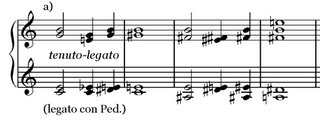The piece I'm working on now, though, has a fair amount of exact repetition, for a variety of reasons. The people I'm writing it for also play in a rock band, so I've been consciously and subconsciously using elements of pop music forms. Also, some of the passages are pretty tricky from a technical standpoint, so (although it's never stopped me before) it seems a little churlish to make them do all that work for a fleeting few bars that never come back. But mostly, it's because, all musical evidence to the contrary, I persist in imagining the piece as an analogue to the sort of multi-movement suites and cycles that Schumann wrote. And Schumann is a master of repetition.
Schumann's repeats can break your heart: the end of Frauenliebe und -leben—after the singer finishes sadly admonishing her husband for dying and leaving her, the piano repeats the opening song of the cycle, where they first meet—is one of the three or four most emotionally devastating moments in all of music. (All the more amazing considering that the emotions embodied in the poetry have dated badly; the distance and loss Schumann conjures up with that simple gesture are, I'm convinced, the main reason the cycle stays in the repertoire.) In the Davidsbündlertänze for piano, the second movement magically reappears in the eighth movement, an unexpected repeat that sets up the enigmatic finale. On the other end, there's the opening movement of Faschingsschwank aus Wien, where the lyricism is always being interrupted by a boisterous beer-hall ritornello: Florestan suddenly showing up to shake Eusebius out of his reverie and drag him back to the party.
But it's the other kind of repetition, the immediate repetition of the phrase, the melody, we've just heard, that Schumann makes his own. Flip through the various pieces that make up the piano cycle Carnaval and you're struck by the sheer variety of where and when repeats turn up. Sometimes it's the opening section ("Promenade"); sometimes the closing section ("Chiarina"). Sometimes a tightly repetitive exposition will give way to a free-wheeling new structure ("Préambule"). Sometimes it's almost as if the music can't let go of the melody ("Aveu"). And sometimes it's as if, by chance, we stumble upon a sudden discovery that freezes us in our tracks ("Florestan"). Schumann, more than any other composer, realized that repetition is it's own form of expressiveness, that, in practice, there's no such thing as an exact repetition, even if the notes are identical. The fact that we've already heard the material means that we'll hear the repeat differently, whether it's finding more meaning in the music, or feeling the meaning of the music slip away into insensibility, the way a word becomes meaningless if you say it over and over. The Greek philosopher Heraclitus famously declared that we never set foot in the same river twice—but he also used to argue from that proposition to the paradoxical idea that, at the same time, everything exists and nothing exists. I don't know about you, but to me, that combination of the fullness of life and the nihilism of the abyss seems awfully Schumannesque.
This past month I found a marvelous use of repetition in music by György Kurtág, who is the closest thing to a modern Schumann that I can think of. (All my MIT keyboard harmony students started with Kurtág pieces this year; sometimes it takes extraordinary measures to get myself psyched up for the semester.) "Hommage à Schubert," from the ongoing piano collection Játékok (Games), is a short piece in two parts. The first part starts:

The second part starts:

The notes are exactly the same. But what in the first part is an out-of-tune hymn, becomes, in the second part, a delicately awkward negotiation between the hands. With an economy of means, he shifts the focus from the disembodied nature of the sound to the physical effort of its production. Not bad for a cut-and-paste. Robert would be proud—although he'd probably repeat it a few more times, just for good measure.

No comments:
Post a Comment